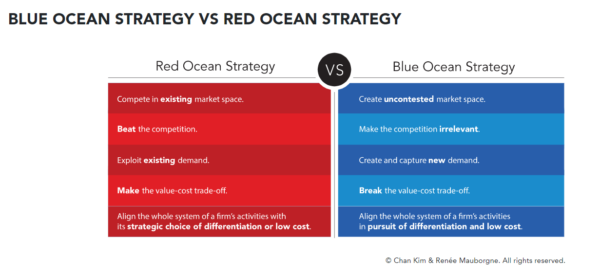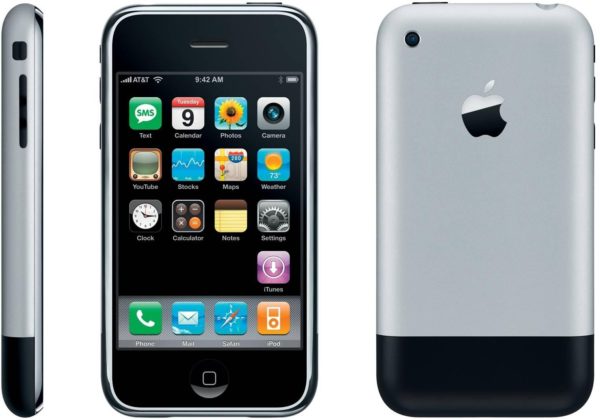
Implementing the blue ocean strategy within your business is a proven way to keep it profitable by reducing competition. Even if you’re operating in a niche market, it is likely that as your business has grown, you have faced increased competition. As other businesses begin eating into your customer base — and your profits — utilizing the blue ocean strategy can help you pivot.
What is the blue ocean strategy?
The term “Blue Ocean Strategy” was coined in 2005 by Professors W. Chan Kim and Rénee Mauborgne. It involves entering a market space with little to no competition rather than trying to compete for customers in an increasingly crowded market.

Blue ocean strategy involves innovating and expanding your products and services to capture new markets in which there are substantially fewer competitors. The term refers to the fact that when there are more businesses competing for the same competitors, competition becomes more cutthroat and “bloody” — i.e., red.
When your market is saturated and you’re trying to find new ways to compete, Kim and Mauborgne consider this a “Red Ocean Strategy.” Their tactics involve shifting away from the crowd and offering new value to different customers. Rather than trying to beat rising levels of competition, blue ocean strategy involves finding a new niche and differentiating yourself to the point that competition is irrelevant.
Adopting this strategy doesn’t mean that you need to abandon your core products and services. Doing so could alienate your most loyal customers. Rather, it involves exploring new markets and niches to serve by finding new uses for your current products or innovating beyond their current use.
Though the term “blue ocean strategy” has only existed for about 15 years, the practice itself is not new. Many companies of all sizes have utilized this strategy to adapt to competitive pressure in their markets. An early example of its successful implementation is the Ford Model T motor car, which was introduced in the early 20th century as an alternative to the horse and buggy. At the time, there was little competition and Ford created a new market.
Companies successfully utilizing the blue ocean strategy
When writing the book that became the foundation for blue ocean strategy, Kim and Mauborgne studied a variety of companies who had used the tactic to start up new businesses or to grow existing ones. Examples of companies who have successfully used similar practices to improve their profitability include the following.
Cirque du Soleil
While Cirque du Soleil is now a household name with dozens of imitators, the performing company revolutionized the circus industry when it was founded in 1984. By that time, the circus industry was dwindling, dominated by a few companies, and expensive to operate.
Rather than competing for traditional circus audiences, which generally consisted of families with children, Cirque du Soleil offered a pared-down experience, eliminating costly animal acts and instead focusing on acrobatics, gymnastics, music, and stunts. Cirque du Soleil’s founders were a group of street performers from Canada who wanted to make a circus performance that was theatrical and sophisticated and would therefore attract a more adult audience.
The company has gone on to develop successful touring productions and a number of staples on the Las Vegas strip, appealing to adults and creating a new audience for its unique performances.
Uber
Uber was conceived in 2009 when its founders wanted an app that let you request a ride from your phone. An advantage to the ride-sharing platform is that drivers could operate their rideshare wherever they were, making it easier for people in suburbs and small cities without large fleets of cabs to find a ride when they needed one.
Uber was so successful in creating a new market that the company quickly faced competition from a number of imitators. However, Uber still remains one of the most popular apps for ride-sharing and has since expanded its portfolio of services to include rental cars and food delivery.
Apple
Tech giant Apple is known for innovation and has successfully used the blue ocean strategy many times to create new markets for its products, particularly when still being operated by company founder, Steve Jobs. When the iPhone first launched in 2007, there were few similar products on the market. Although there were several phones that let people answer email and access the internet, the iPhone went beyond the typical smartphone technology of the time.
The iPhone gave users a phone, computer, GPS navigator, MP3 player, handheld video game operating system, and much more in one device. Apple allows its employees to be creative and use their talents to find new ways to solve consumer problems — and its products often make the competition irrelevant.

When other tech companies caught up by imitating Apple’s innovations, the company was often already onto the next product.
Tesla Motors
Another company known for invention, Tesla Motors was one of the first companies to delve into the idea of a 100% electric car. Although Toyota and other car manufacturers had previously introduced hybrid models, Tesla appealed to buyers who didn’t want to fuel their cars with even a small amount of gasoline.
Early electric cars — and even hybrid models — have been criticized for not being able to travel long distances without being charged and not offering the same level of performance as a traditional car. But Tesla has continued to adapt its cars and has now found success with traditional car buyers as well as electric vehicle consumers.
Quicken
Intuit utilized a blue ocean strategy when developing its Quicken financial software. Prior to this development, individuals who wanted to get a handle on their finances either had to do it themselves or hire a CPA for more complicated needs. Quicken gave ordinary people options while introducing the software company to a new customer base.
How your business can launch a blue ocean initiative
If you find yourself facing an increasingly saturated market, there are steps you can take to implement a blue ocean strategy to improve your revenues.
1. Define your current situation
Before you can innovate your product or find a new niche, you need to determine your current market. What are the attributes and benefits of your current product or service? What are the strengths and weaknesses of your employees?
Use these questions to find your new niche. For example, some pharmaceutical companies have used beneficial side effects of current medications to have them approved and marketed for new uses, creating additional customers.
Work with your employees to brainstorm what you do well and areas where you can provide value to other clients. Including your employees in the process opens you up to new ideas, and it helps create buy-in on the process. Some of your employees may be afraid of pivoting to a new business strategy, so including them in the process can help ease these fears.
2. Identify new opportunities
While analyzing your current situation and identifying new target markets, look for current obstacles created by existing products or services and find new ways to solve these problems. Tesla, for example, found a way to make functional cars that don’t impact the environment without sacrificing performance and quality.
The company began producing electric cars and has since refined them so that they perform as well as, or better than, their luxury counterparts.
Evaluate your strengths as a company and figure out how you can use them to provide new solutions to problems that have been created by your industry. You can also use this approach to look for new customers who will benefit from your existing product or service.
Cirque du Soleil, for example, decided to focus on the theatrical and artistic aspects of circus performance to tap into a different customer base than the typical circus-going family.
3. Modify your product or service
It’s likely that your new target market won’t like or need certain aspects of your product or service. Modifying these features — and perhaps eliminating undesired aspects of the product — opens your product up to new customer groups who thus far have not needed your product as it currently functions. When Apple decided to offer smartphones, the company completely did away with keypads, shifting entirely to a touch screen.
This feature wasn’t desired by the target customer for the iPhone, and it was undesirable to people who preferred phones with a traditional keypad. Another company that used this strategy in its inception was Netflix. It was conceived by an angry video store patron who was tired of paying late fees for video rentals and decided to offer movie rentals through the mail without the inconvenience of late fees.
Initially, Netflix customers were simply those who didn’t want to drive to a video store and didn’t mind waiting a few days for their movie to arrive in the mail. Later, Netflix added streaming services and video production to its services and has become an industry giant.
Shifting away from your traditional design could alienate your existing customers, but it’s often a necessary part of shifting into a new market. You can always develop blue ocean strategies for complementary products and services that let you keep your top-tier clients, but then you risk no longer being seen as innovative.
4. Test your new products
Now that you’ve selected your new target market and modified your product, launch a test. Make a prototype and conduct market research with members of your new target market. Getting feedback through focus groups, video demonstrations, social media, and other tools will help you determine the potential success of your product and identify areas that still need to be refined.
If there is substantial feedback regarding a certain aspect of your new product, use it to change the design and functionality and then retest the new model. Keep going until you find something that is viable to launch to a new audience.
5. Use digital marketing tools to promote your new product to your target audience
Even though you’re not a startup, a blue ocean strategy involves identifying and targeting new customers for your products. You will likely have to build brand awareness and educate new customers about your product in order to make it successful.
Use digital marketing tools to introduce your new offering. If you have an email list, send out a blast informing current customers of your new product. Even though they aren’t in your new market, they may have people in their network who are. Since they are already familiar with your brand and its quality, they can become advocates to new clients.
This is also a good opportunity to segment your list. Use paid ads and other marketing tools to drive new users to your website and create a new segment for your new target market. Send out tailored messages communicating the benefits of your product or service to your new audience.
Use long-form content like blog posts and videos to build brand awareness among your new target market. Find companies who successfully operate in your target market and offer to write guest blogs. You can use existing brand awareness for a complimentary product or service to build visibility for your own company.
Using blue ocean strategy to move ahead of the competition
Your company is likely facing increased competition. Devising a blue ocean strategy lets you concentrate on new problems you can solve in more innovative ways. This helps make your competition irrelevant and allows you to break free of the pressures involved with trying to capture a larger share of a shrinking market.
If you’re ready to try implementing a blue ocean strategy, start by identifying your most forward-thinking employees and work together to find new problems you can solve with your products and services. Once you’ve identified your new target market, devise new products and test them out.
You might end up trying and failing a few times before successfully implementing your strategy, but knowing how to create and execute these strategies helps your company be more resilient over time.




